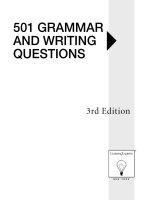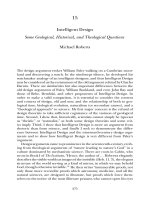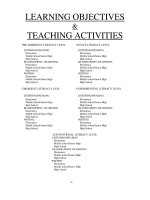Objectives and essential questions
Bạn đang xem bản rút gọn của tài liệu. Xem và tải ngay bản đầy đủ của tài liệu tại đây (252.08 KB, 14 trang )
VECTORS
Level 1 Physics
Objectives and Essential
Questions
Objectives
Distinguish between
basic trigonometric
functions (SOH CAH TOA)
Distinguish between
vector and scalar
quantities
Add vectors using
graphical and analytical
methods
Essential Questions
What is a vector
quantity? What is a
scalar quantity? Give
examples of each.
SCALAR
A SCALAR quantity
is any quantity in
physics that has
MAGNITUDE ONLY
Number value
with units
Scalar
Example
Magnitude
Speed
35 m/s
Distance
25 meters
Age
16 years
VECTOR
A VECTOR quantity
is any quantity in
physics that has
BOTH MAGNITUDE
and DIRECTION
ρr r r
x, v , a, F
Vector
Example
Magnitude
and
Direction
Velocity
35 m/s, North
Acceleration
10 m/s2, South
Force
20 N, East
An arrow above the symbol
illustrates a vector quantity.
It indicates MAGNITUDE and
DIRECTION
VECTOR APPLICATION
ADDITION: When two (2) vectors point in the SAME direction, simply
add them together.
EXAMPLE: A man walks 46.5 m east, then another 20 m east.
Calculate his displacement relative to where he started.
46.5 m, E
+
66.5 m, E
20 m, E
MAGNITUDE relates to the
size of the arrow and
DIRECTION relates to the
way the arrow is drawn
VECTOR APPLICATION
SUBTRACTION: When two (2) vectors point in the OPPOSITE direction,
simply subtract them.
EXAMPLE: A man walks 46.5 m east, then another 20 m west.
Calculate his displacement relative to where he started.
46.5 m, E
20 m, W
26.5 m, E
NON-COLLINEAR VECTORS
When two (2) vectors are PERPENDICULAR to each other, you must
use the PYTHAGOREAN THEOREM
Example: A man travels 120 km east
then 160 km north. Calculate his
resultant displacement.
FINIS
H
the hypotenuse is
called the RESULTANT
160 km, N
c 2 = a2 + b2 → c = a2 + b2
2
VERTICAL
COMPONENT
2
c = resultan t = [(120) + (160) ]
c = 200 km
120 km, E
HORIZONTAL COMPONENT
WHAT ABOUT DIRECTION?
In the example, DISPLACEMENT asked for and since it is a VECTOR quanti
we need to report its direction.
N
W of N
N of E
E of N
N of E
N of W
W
NOTE: When drawing a right triangle
that conveys some type of motion, you
MUST draw your components HEAD
TO TOE.
E
S of W
S of E
W of S
E of S
S
NEED A VALUE – ANGLE!
Just putting N of E is not good enough (how far north of east ?).
We need to find a numeric value for the direction.
200 km
θ N of E
120 km, E
160 km, N
To find the value of the
angle we use a Trig
function called
TANGENT.
opposite side 160
Tanθ =
=
= 1.333
adjacent side 120
θ = Tan −1 (1.333) = 53.1o
So the COMPLETE final answer is : 200 km, 53.1 degrees North of East
What are your missing
components?
Suppose a person walked 65 m, 25 degrees East of North.
What were his horizontal and vertical components?
H.C. = ?
The goal: ALWAYS MAKE A RIGHT
TRIANGLE!
25
To solve for components, we
often use the trig functions since
andadjacent
cosine. side
opposite side
V.C = ?
65 m
cosineθ =
hypotenuse
adj = hyp cos θ
sineθ =
hypotenuse
opp = hyp sin θ
adj = V .C. = 65 cos 25 = 58.91m, N
opp = H .C. = 65 sin 25 = 27.47m, E
Example
A bear, searching for food wanders 35 meters east then 20 meters
north. Frustrated, he wanders another 12 meters west then 6
meters south. Calculate the bear's displacement.
-
12 m, W
- =
6 m, S
14 m, N
20 m, N
35 m, E
R = 14 2 + 232 = 26.93m
14 m, N
R
θ
23 m, E
=
23 m, E
14
= .6087
23
θ = Tan −1 (0.6087) = 31.3
Tanθ =
The Final Answer: 26.93 m, 31.3 degrees NORTH or EAST
Example
A boat moves with a velocity of 15 m/s, N in a river which
flows with a velocity of 8.0 m/s, west. Calculate the
boat's resultant velocity with respect to due north.
Rv = 82 + 152 = 17 m / s
8.0 m/s, W
15 m/s, N
Rv
θ
8
Tanθ = = 0.5333
15
θ = Tan −1 (0.5333) = 28.1
The Final Answer : 17 m/s, @ 28.1 degrees West of No
Example
A plane moves with a velocity of 63.5 m/s at 32 degrees South of
East. Calculate the plane's horizontal and vertical velocity
components.
H.C. =?
32
63.5 m/s
adjacent side
cosineθ =
hypotenuse
adj = hyp cos θ
V.C. = ?
opposite side
sineθ =
hypotenuse
opp = hyp sin θ
adj = H .C. = 63.5 cos 32 = 53.85 m / s, E
opp = V .C. = 63.5 sin 32 = 33.64 m / s, S
Example
A storm system moves 5000 km due east, then shifts
course at 40 degrees North of East for 1500 km.
Calculate the storm's resultant displacement.
1500 km
40
5000 km, E
H.C.
adjacent side
hypotenuse
V.C.
adj = hyp cos θ
cosineθ =
opposite side
hypotenuse
opp = hyp sin θ
sineθ =
adj = H .C. = 1500 cos 40 = 1149.1 km, E
opp = V .C. = 1500 sin 40 = 964.2 km, N
2
2
R
=
6149.1
+
964.2
= 6224.2 km
5000 km + 1149.1 km = 6149.1 km
964.2
Tanθ =
= 0.157
6149.1
R
964.2 km
θ = Tan −1 (0.157) = 8.92 o
θ
6149.1 km
The Final Answer: 6224.2 km @
8.92 degrees, North of East









